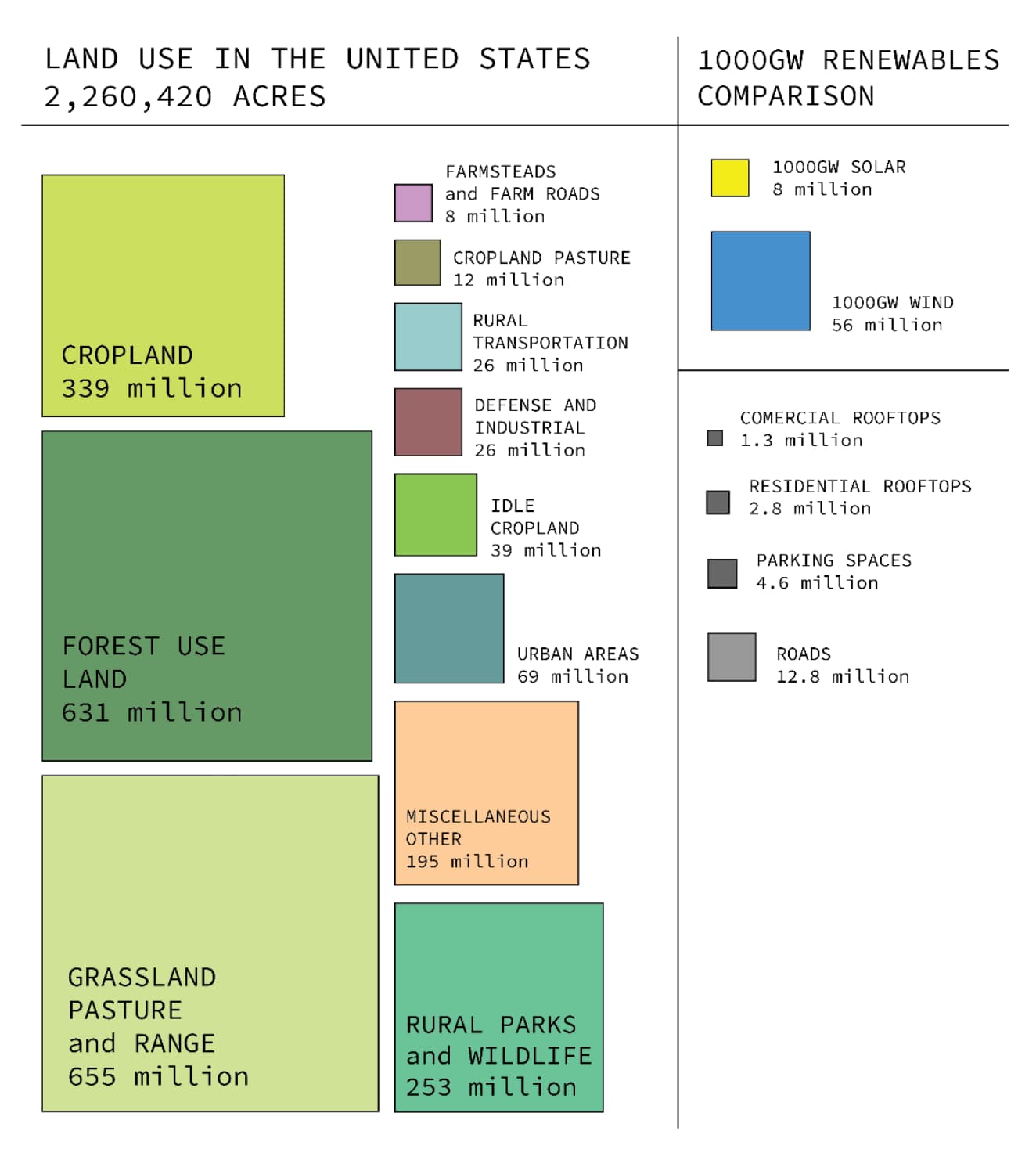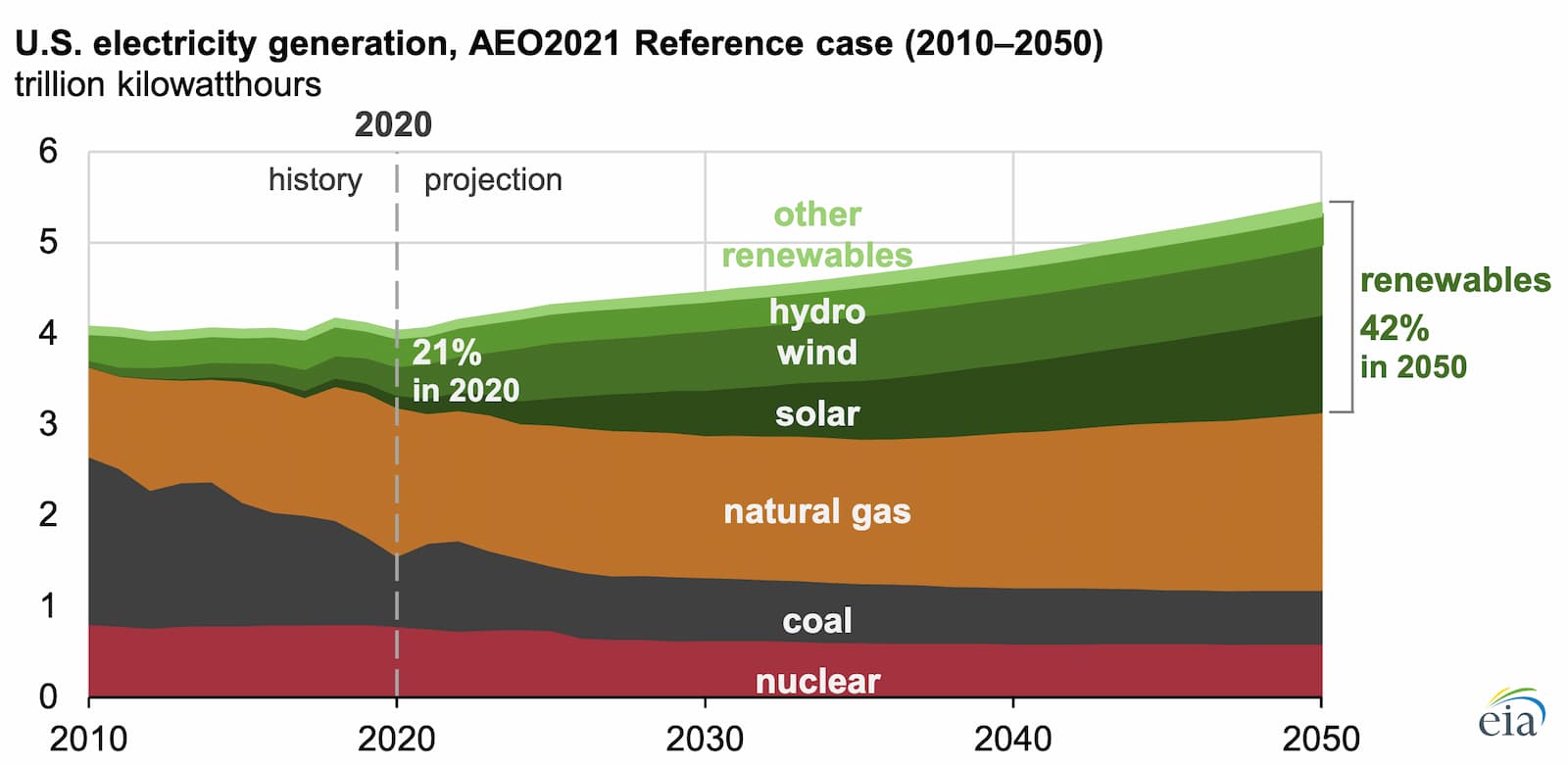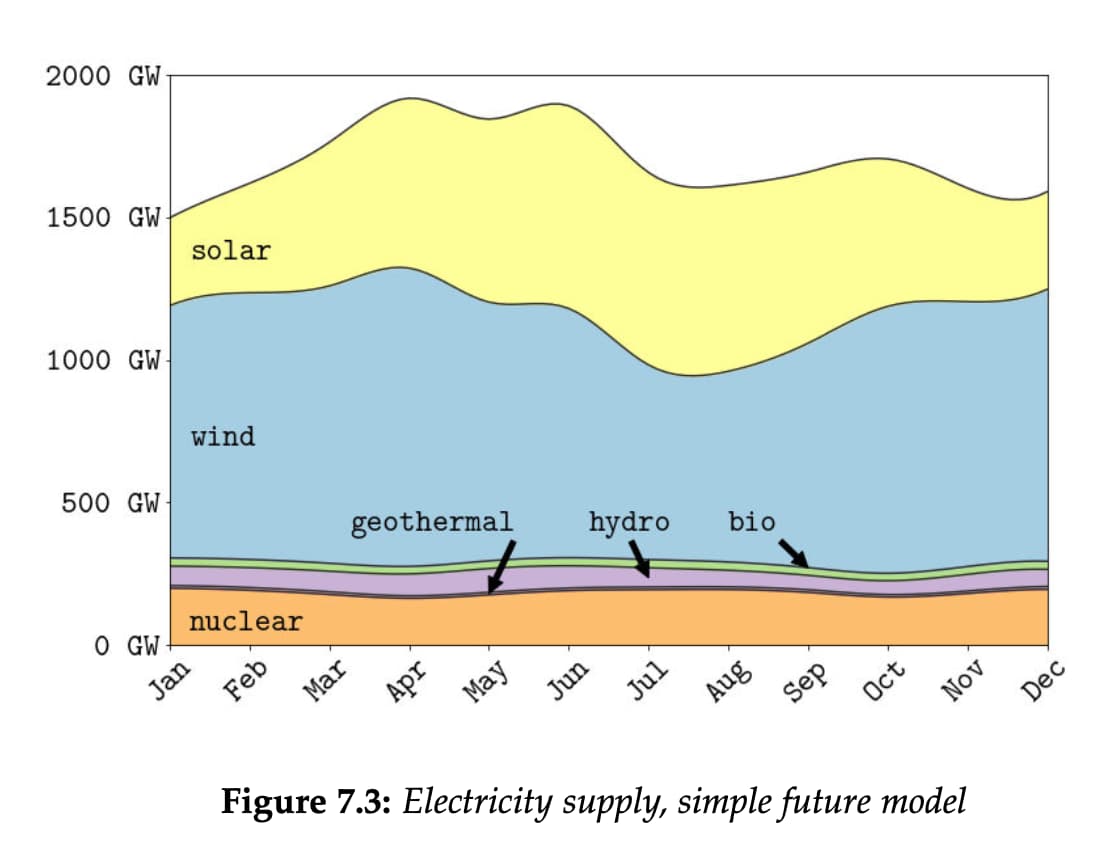I’m in Seattle through the end of September and would love to meet up with y'all (especially those of you working in energy, synthetic biology, or robotics).
Decarbonization
Emitting CO2 is bad and a bunch of countries have promised to stop by 2050.
How’s that going to work?
In Rewiring America Saul Griffith et al. (who also brought us the US Energy Flow Super Sankey Diagram) argue that:
we need to electrify everything, “never purchasing machines or technologies that rely on burning fossil fuels ever again”
- this will reduce our energy needs by 50%, as heat pumps and electric motors/generators are more efficient than their combustion counterparts
- adoption will require extensive mandates and subsidies; “the ‘free market’ as we know it is not up to the task”
this will take 1500–1800 GW of electricity
- “more than three times the amount of electricity that we currently produce”
- generated mostly from wind and solar
I’ll take Griffith’s facts as given, though I did find many of them surprising. In particular, the amount of land America would need to dedicate to a solar and wind-based energy supply.
(If you, like me, have never previously thought about this question, try making an estimate now; I recommend a comparative answer like “X% of the land used by houses”.)
I’ll discuss this (underappreciated) land use aspect along with claims I found either dubious (e.g. load shifting) or unsatisfyingly discarded (carbon taxes, nuclear). Finally, I’ll go beyond the scope of Rewiring America to speculate about political economy and the rest of the world.
I should underscore that Griffith has been thinking about all this much harder and longer than I have (early 2000’s versus, uh, last month), and I’m using their book as a scaffold on which to:
- share my nascent, numerate sense of the situation
- convince you to email or tweet me about my (likely many!) fundamental misunderstandings and crucial factors I’ve overlooked
Land
This graphic from Kirk Von–Rohr (via Rewiring America) summarizes the land requirements well:

Generating 1500–1800 GW from photovoltaic solar would take about the same amount of land as 400% of all residential and commercial rooftops. Alternatively, all of America’s roads and parking lots combined.
Wind turbines must be spaced apart from each other and are even less energy dense than solar. While the area between turbines could be used for other purposes — maybe solar or agriculture — it wouldn’t be pleasant to occupy.
I used to develop operations software for wind farms and can confirm that, up close, turbines are loud, imposing, and terrifying. This one isn’t even moving and you can tell I’m still awkwardly nervous (also note just how far away the closest buildings are in the background):

In some sense it’s obvious that the energy generation density of solar and wind is constrained by the, uh, mild-ness of sunshine and wind, but the scale of the issue only dawned on me when, you know, all of America’s roads and parking lots combined.
According to Griffith:
There can be no “not in my backyard” with solar and wind energy.
Whether this is a fatal roadblock to American decarbonization via solar and wind depends on whether you feel Americans will allow each other to build physical things.
Or, since 25% of American land is federally owned (including 85% of sunny Nevada and 39% of Arizona), perhaps we could build without messing up anyone’s backyard? Yeah, transmission losses exist, but they might be more easily overcome than the social/legal challenges of building near Americans.
While Griffith doesn’t investigate this question, the numerate-yet-accessible 2009 classic Sustainable power without the hot air discusses (among many other things, go read it!) the construction of a Germany-sized solar power station in North Africa, bringing back enough power via a 3500 km high voltage DC line to supply a billion Europeans with their current consumption levels of energy.
Alternatively, perhaps the staggering amount of land required makes wind/solar more likely to happen, as it makes them a politically viable mechanism for transferring federal funds to geographically broad constituencies. Agriculture wears this (dubious) crown today — about 20% of American farm income comes from direct government payments — but perhaps energy could grow to match agriculture’s share (today it’s 0.16% vs. agriculture’s 0.41% of the federal budget’s FY2021 obligated amount).
Electricity production costs
The good news is that utility solar is already cost competitive with fossil fuels. Sometimes cheaper, in fact: The levelized cost (which includes capital costs and depreciation) of solar ($0.03–$0.04/kWh) is comparable to the “marginal cost of operating fully depreciated gas combined cycle, coal and nuclear facilities” (see Lazard’s 2020 analysis).
In a previous newsletter I linked to Handmer’s 2019 position and, two years later, they’re even more bullish:
At present rates of growth, non-solar sources of energy will likely be excluded from the market by 2030.
This optimism is difficult to reconcile with the US Energy Information Administration’s forecast that the electricity generation mix will be only 42% renewables in 2050:

However, I spoke with a Department of Energy insider, who explained that “[EIA models are] deeply conservative when it comes to learning curves / technological change”. (See also Naam’s “Appendix 2: Why are solar forecasts so wrong?”)
For the sake of argument, let’s assume solar’s levelized cost stays below the marginal cost of fossil fuel plants. (The decreased productivity of expanding into less sunny places is balanced out by continuing returns to scale in declining equipment and installation costs.)
In that scenario, America can shift from its current fossil-dominant mix (60% fossil, 20% nuclear, 20% solar/wind/hydro) to a majority solar/wind mix?
Well, it’ll be tricky.
Variability
The main source of trickiness stems from solar and wind being both variable (predictable outages from, e.g., night) and intermittent (unpredictable outages from clouds, wind lulls).
For solar, aside from night, there’s also the issue of winter, where shorter, less sunny days means US average solar generation is about 50% that of summer. (Which isn’t too bad compared to countries at more extreme latitudes: Germany’s winter production is only about 20% summer’s.)
Griffith outlines a production mix dominated by wind most of the year:

noting:
To reliably provide enough electricity for all demands, all year long, we’d only need to overbuild our supply capacity by about 20%. At 2-4¢/kWh for grid–scale electricity, that would only increase the cost of our generation capacity by 0.5-1¢/kWh — a much cheaper option than any of the batteries we have discussed above.
Handmer predicts solar’s rapidly falling costs will lead it to dominate:
The natural end state of this transition is 5-15x solar capacity overbuild (it’s very cheap) with enough batteries to load shift over a diurnal cycle for levels of consumption that currently look quite high, due to future low prices and induced demand. No gas, no coal, no nuclear. Wind, yes, in windy cloudy areas.
The exact mix of solar + batteries and wind will depend on the economic viability of grid-scale batteries, but unfortunately, neither Griffith nor Handmer go into much detail about their calculations.
The most detailed prediction I could find was an NREL report on diurnal batteries which suggested that, based on existing policies by 2050:
variable renewable energy (VRE) reaches penetrations of 43-81%, but does not achieve the deployment needed to meet deep decarbonization goals
(See also NREL’s Grid-Scale Battery Storage FAQ.)
An MIT analysis from 2018 finds that:
For zero emissions cases without firm resources, the total required installed generation and storage power capacity in each system would be five to eight times the peak system demand
and highlights that:
Availability of firm low-carbon resources reduces costs 10%–62% in zero-CO2 cases
So we’ll almost certainly want some “firm” power sources like nuclear and natural gas for those windless winter nights.
As an aside: If we do overbuild supply without any breakthroughs in seasonal storage, we’ll occasionally have periods of free electricity (e.g., windy summer days). It’s fun to speculate about potential activities at this frontier. Aside from computing hashes (a recently popular, uh, aesthetic pursuit), one could extract nitrogen fertilizer from the air (directly useful) or carbon itself (virtuous).
Demand shifting
As for handling daily variability, Griffith is optimistic about demand shifting:
Smart controls on most of our appliances will allow them to coordinate such that our loads won’t collide, our dishes will get done, our homes will be warmed, and we won’t even notice it seamlessly happening.
I’m skeptical about this at the consumer-level. Like the broader climate problem, the challenge is convincing individuals to bear direct costs (replacing appliances, tolerating service disruptions) for an abstract, diffuse benefit (grid stability / decarbonization).
Even assuming that people can be convinced (or coerced) into “smart appliances”, it’s not clear the benefits outweigh the implementation risks.
For example, last week the Google note-taking app running on my Google phone lost several years worth of notes because I logged out of and back into my Google account. (Google, which been working on phones for a decade, is a company widely recognized as being good at computers.)
Given this technological track record, it’s not obvious to me that a billion “smart” devices from dishwasher and water heater companies will improve any kind of network they’re attached to, electrical or informational.
I’m more optimistic about demand shifting in large commercial and industrial domains, as those customers already employ bean-counters to optimize expenses and otherwise rationally direct their consumption. (Not to mention that these customers are actually exposed to electricity market price signals — here in Seattle, for example, large commercial customers pay 10x for peak-time electricity, while residential customers pay fixed-rates regardless of time of day.)
That said, I’m not sure how to rectify Griffith’s assertion that “industrialists like to keep their capital equipment running at full capacity” with their statement three paragraphs later that “our steel mills and aluminum smelters will be critical and shiftable large loads that can be moved to match supply”.
Presumably these questions will be decided by micro-level industry/regional/individual capex vs. opex ratios. It’s unclear to me whether that cumulative macro impact is meaningful compared to over-provisioning intermittent supplies or developing battery systems.
Structurally, however, I do agree with Griffith that the electrical grid should be “neutral” and treat:
everyone connected to it as both a supply and a demand, and as a load–shifter, and as a battery.
Markets are one of our best cooperative technologies, and the more people we allow into electricity markets — from individual consumers to massive suppliers to battery arbitrageurs — the more we’ll be able to coordinate our innovative efforts.
Financing electrification
Recall that generating carbon-free electricity isn’t the full decarbonization story — we still need to replace our fossil-fuel powered transportation, heating, and industrial machinery with electric alternatives.
Griffith casts this as a problem not of technological capabilities, but of finance, arguing that we must invent the “climate loan”:
All of the technologies for decarbonization have high up–front capital costs, and low lifetime fuel and maintenance costs. America solved finance problems that looked like this when we invented auto financing in the 1920s, the modern 30–year government–guaranteed mortgage in the 1930s, and rural electrification during the New Deal. We need something analogous today.
As with the supply numbers, I’ll trust their technical analysis and assume electrification is cheaper over the long run.
But in that case, if there are real economic savings to be had, why wouldn’t private capital (desperate for yield after years of low interest rates) step in? If there’s some market failure here that requires government support to correct, Griffith doesn’t spell it out.
Alternatively, let’s say electrification isn’t actually cheaper but we as a society decide to take the GDP hit to save the ice caps anyway.
Is the most effective strategy towards this goal subsidizing consumption?
Griffith’s own analogy with government subsidies for cars and single-family detached homes seems like the perfect example of the unintended consequences. As it turned out, just a few decades of those policies led to:
“home ownership” becoming synonymous with “savings”, which exacerbated wealth inequality and led owners to defend their life’s savings (house valuation) by opposing nearby construction, leading to urban sprawl
which resulted in our entire society being literally built around the self-fulfilling prophesy that everyone has their own automobile
The American government created suburbia through mortgage subsidies, homeowner tax benefits, and by socializing the costs of road infrastructure, etc. This blew up America’s per-capita carbon emissions (about twice the UK or Germany) in a way that’s now politically near-impossible to curtail.
The federal gasoline tax, for example, isn’t indexed to inflation and hasn’t been raised since 1993 (in real terms, it’s 77% lower today). Politically this is unsurprising, since such a tax would impose direct costs on nearly all voters, who’re compelled to drive around a sprawling built environment if they wish to participate in society.
(Not to mention all the other unintended consequences like reduced labor mobility and increased individual and systemic volatility; see Hobart’s The 30-year mortgage is an intrinsically toxic product.)
Griffith seems to fall into the same trap as so many well-meaning environmentalists, thinking that fuel efficiency, solar panels, and electric vehicles are good.
This kind of thinking can result in regulations with absurd environmental and social consequences. For example, I would absolutely love to have one of these small pickups I’ve seen all over Taiwan and Japan:

You can park it in tight city spaces! You can deadlift things into the low bed! It comes with a Shiba Inu co-pilot!
Unfortunately CAFE fuel economy standards make it illegal for these adorable kei trucks to be sold in America.
However, the Federal government will pay you $7,500 to drop $40,000 on an electric F-150 that’s almost 20 feet long and requires an Olympic snatch to lift anything into the bed.
To be clear, my objection is not in the details of fuel economy restrictions or tax credits (though I’m sure you can guess whether people too poor to buy new electric vehicles are paid by the Federal government for buying bicycles). My objection is that special interest horse-trading misses the larger point: Emitting carbon is bad.
Maybe we could just, uh, discourage that directly?
Taxing carbon emissions seems much easier to implement than agreeing on the exact lifestyle our government should finance. Are we giving everyone cheap cars? How many per family? What about cheap electric short-haul flights? Should we make it cheaper for Americans to live in hot vs. cold places; in detached houses, apartments, or town homes; in the city or in the countryside? How much will the government pay to electrify steel and aluminum producers? Even when all the opex savings will be accrued by foreign owners? What about electrifying oil refineries? (I mean, we’ll still need plastic…)
Griffith asserts that “A carbon tax isn’t fast enough” but doesn’t explain why I should trust them over The Largest Public Statement of Economists in History:
A carbon tax offers the most cost-effective lever to reduce carbon emissions at the scale and speed that is necessary.
Of course, people have been trying to implement an American carbon tax ever since we noticed global warming 40 years ago. So perhaps the argument is one of political economy: Taxes are unpopular, so it’ll be easier to “overpay” for decarbonization by giving everyone electric stuff they otherwise wouldn’t have purchased themselves.
If so, the argument isn’t actually made; instead, Griffith simply asserts “[Carbon taxes] would be difficult to implement, as well as regressive, hitting lower–income people hardest”. Unfortunately, those same implementation and fairness questions concerns apply to complex government subsidies, financing, and mandates of “climate loans”, which Griffith also doesn’t discuss.
Luckily, regardless how much we subsidize consumption and/or discourage carbon emissions, electric products tend to be superior to their combustion-based counterparts. Without the need to contain literal explosions, products can be made from less expensive materials; they’re lighter, cheaper, less noisy, and don’t emit noxious fumes. Today, no one is buying an electric lawnmower as a political statement; they’re just buying a better lawnmower.
The rest of the world
While Griffith’s book is titled Rewiring America, since America’s carbon emissions are only about 11% of the world total it’s worth asking whether that decarbonization strategy will generalize to other countries.
Unfortunately, the low energy density of wind and solar which makes the Rewiring America strategy difficult here makes it even harder in many other countries, which lack vacant land. (Sorry, I still can’t get over all of America’s roads and parking lots combined.)
Take a look at the average population density of the most populous countries: China is about 5x denser than the US, India 13x, Indonesia 5x, Pakistan 8x. Brazil, the sixth most populous country, is the first with density roughly comparable to the US (about 0.7x), but I don’t think even the most pro-solar environmentalists will enjoy seeing the land they’d need to clear-cut to deploy panels.
To their credit, Griffith acknowledges this:
in other countries with very high population density or a lack of renewable resources, nuclear or imported renewables are the only realistic options.
Even if the land-intensive strategy only works in rich, geographically-expansive countries like America, Australia, and Canada, it’s still worth considering how their adoption of such strategies will impact the rest of the world.
First, let’s consider learning effects (“Wright’s Law”) and returns to scale, where doubling output reduces costs by 10–30%. (This is how solar became cheap in the first place.)
If the West invests in renewables which can’t scale to meet world needs, that means less money invested in the technologies that will scale. So we won’t climb as high as we could have on the learning and scaling curves for those technologies, and it’ll cost the world as a whole much more to electrify.
While I’m sure there will be positive technological and labor spillovers from further developing utility-scale wind and solar, from purely a climate / decarbonization perspective (noting that we’re all using the same atmosphere) it seems like we shouldn’t waste our efforts on things we know won’t scale.
Second, consider not the technological constraints of solar, but the political one: China dominates all steps of solar panel production:

The West purchasing a trillion dollars of solar panels would be a substantial transfer of wealth to (for those of you unfamiliar) a country run by an authoritarian regime currently engaging in genocide.
In fact, this particular PRC genocide of the people in Xinjiang is directly connected to solar. Uyghur Forced Labour and Global Solar Supply Chains summarizes:
- Polysilicon manufacturers in the Uyghur Region account for approximately 45% of the world’s solar-grade polysilicon supply.
- All polysilicon manufacturers in the Uyghur Region have reported their participation in labour transfer programmes and/or are supplied by raw materials companies that have.
The US is currently deciding which solar imports to ban because of this.
Of course, neither slavery nor total reliance on a single foreign power are inherent to solar — Americans invented the technology and with the right industrial policy we might learn how to manufacture it at scale.
But today, the reality is that solar is cheap in part because of ethnic minority forced labor. Buying panels in the current market solidifies the technological lead of that undemocratic regime, and any solar-dominated energy transition plan must directly address these moral and geopolitical trade-offs.
Optimism
As I mentioned at the top, even though I’ve heard about global warming my entire life, I only started researching it last month.
Griffith et al’s Rewiring America has been a wonderful numerate introduction to the situation. Before their book, I didn’t fully appreciate the magnitude of our energy usage and reliance on fossil fuels:
If you had a giant set of scales and put all the things humans make or move on one side, and all of the CO2 we produce on the other, the CO2 would weigh more.
All of the planet’s trees and grasses and other biological machines pull a grand total of about 2GT of carbon a year. To put that in context, our fossil burning is emitting 40GT a year.
Nor did I understand the land needed by wind and solar. Early in my career I worked on wind farms, and the past few years I’ve seen more and more Teslas driving around and solar panels on houses — I figured things were coming along great.
But now, uh, (last time, I promise) all of America’s roads and parking lots combined.
I agree with the Rewiring America authors on their framing of the problem: electrification is necessary, we must act quickly and at scale, and that
it would be unwise to bet our future on miracles, as our timeline for climate change solutions is too short.
Our disagreement stems from what we consider miracles. They’re referring to technologies like “fusion, next-generation nuclear fission, direct solar rectification, airborne wind energy, high-efficiency thermoelectric materials, [and] ultra-high density batteries”.
But those seem, to me, less miraculous than the West realizing the political capacity to centrally plan a comprehensive electrification program or to socially breakthrough “not in my backyard” enough to build literally millions of acres of solar and 10’s of millions of wind.
Perhaps some acute, highly visible climate catastrophe would mobilize Americans into the collectivist, World War II-like, “failure is not an option” mindset that the Rewiring America plan requires — but I’m not counting on it.
Rather, my optimism comes from learning more about a technology we’ve had since the 1950’s: nuclear fission.
The technology isn’t hypothetical; it has been built at scale, both for grid electricity (10% world supply; 70% of France’s, 40% of Sweden’s) and carbon-free transport (every US Navy submarine and supercarrier built since 1975).
In the US, although nuclear only makes up 20% of the electric supply, that’s a larger share of the total carbon-free electricity supply than solar, wind, and hydro combined. (And nuclear has been generating this carbon-free electricity for the past 50 years.)
The safety record is excellent in the same pathological way that commercial aviation and vaccines are safe — every mis-step is covered by sensational, terrifying headlines. It’s telling that the “Our World in Data” figures count against nuclear:
574 deaths from Fukushima (one worker death, and 573 indirect deaths from the stress of evacuation)
Like vaccines, nuclear energy is an emotionally charged topic and many people (understandably!) fear side effects. However, we must not lose sight of the effects of the disease itself:
We estimate a global total of 10.2 million premature deaths annually attributable to the fossil-fuel component of PM2.5
(Beyond air pollution, there’s the rest of this global warming stuff too, which I’m told is also quite bad.)
Yes, it’s incredible that we have the space to build solar and wind in America, and that these renewables are so cost-competitive — I’m looking forward to seeing them erode our electric grid’s reliance on fossil fuels.
But they can’t scale to solve the global problem.
Solar and wind are the “let’s just lockdown and work from home” solution; a luxury accessible to those with the wealth, space, and cash flow to isolate themselves from an emergency.
I didn’t start my research with any sort of agenda; the closest I’ve been to any sort of energy activism was skipping high school to protest the 2003 Iraq invasion. Rewiring America barely touches on nuclear, and it came on my radar from an interview with climate activist Mark Lynas:
Arden Koehler: All right. Let’s move on from nuclear power to discuss other promising ways people can help to reduce climate change. What are a few other policy or technology options that you think have the greatest potential to avoid a climate disaster?
Mark Lynas: There aren’t any.
Arden Koehler: So it’s just nuclear?
Mark Lynas: Yep.
Lynas frames the problem in terms of energy density and material flows. Humanity has spent a hundred years burning CO2, and those emissions literally outweigh the cumulative total of everything else we’ve ever made or moved.
Not only do we need to grow our energy supply to lift billions out of poverty without emitting additional carbon, if we want to limit global warming to 1.5 degrees Celsius we must also capture CO2 directly from the air. As this is basically the reverse of the burning that’s powered humanity thus far, it will require a lot of energy.
James Hansen, the climate scientist who raised broad awareness of climate change in his 1988 Congressional testimony, says that “Nuclear power paves the only viable path forward on climate change”.
My personal optimism stems from the energy density of nuclear — compared to fossil fuels (and certainly compared to solar/wind), the total land and environmental impacts of the nuclear supply chain are minuscule.
The rising costs and construction delays that killed the American nuclear industry in the 1970’s were driven by regulation and industry structure, not by inherent technical limitations.
While I’m not sure whether Americans will ever allow themselves to build cheap, effective nuclear power, luckily the proven technology is within reach for developing nations who’re forced to take climate change more seriously.
In terms of difficulty, well, the US Navy started looking into nuclear around 1948, when the US population was around 150 million and per-capita GDP around $14k (2011 dollars). Within 5 years they invented the pressurized water reactor (the basis of most commercial plants today) and by 1954 they launched a submarine:

This was 70 years ago! They did all the calculations with slide rules and drew the plans on big sheets of paper! I mean, just look at all the fedoras! (high-resolution photo)
Today, developing countries like Brazil, China, and Indonesia have comparable per-capita GDPs and they don’t even need to invent anything! (The Russians are happy to help too; they’re currently building 36 nuclear power plant units in 12 countries.)
Beyond the classic hundreds-of-megawatt, water-moderated designs, fission startups are exploring new variations:
Oklo’s 1.5MW micro-reactor is the first “advanced fission” design to be accepted for review by the US Nuclear Regulatory Commission
ThorCon is scaling up an Oak Ridge molten salt reactor design as a ship in Indonesia (the team previously built the world’s largest oil tankers)
NuScale has raised a few hundred million dollars to build modular small (~80 MW) light water reactors
TerraPower is designing a sodium fast reactor to replace coal within an existing power plant in Wyoming
Furthermore, over the past decade there’s been more than a billion dollars of private investment into fusion startups, who’re leveraging advances in high-temperature superconductors, computation, and lasers. (Plus the transferable research/engineering and credibility tailwind of $25 billion of joint governmental funding into ITER.)
Without getting into the details (perhaps in a future newsletter), based on the energy density arguments alone I’m convinced that nuclear could play a substantial, if not dominant, role in decarbonizing the global energy supply, alleviating poverty, and actively reversing global warming.
Conclusion
That nuclear power is technically capable of enabling energy abundance says nothing about if, or when, humanity will take full advantage of it. There are plenty of reasons to be skeptical, especially in the near term of the next few decades:
nuclear development might continue to be trapped by popular opinion and the supporting regulation (e.g., the West’s early 00’s “nuclear renaissance” culminated with the construction cost overrun-driven bankruptcy of Westinghouse; what’s different about the next two decades?)
even if we do start building, the learning rate from building small modular reactors might turn out to be insufficient to compete with renewables (major nuclear costs stem from already highly-optimized technologies like steam turbines)
humanity might continue to limit its ambitions, satisfied with 1970’s levels of energy consumption (maybe swap the fossils with wind/solar, but no flying cars)
While I certainly hope to work towards and live under the energy abundance attainable through nuclear, I’m not sure if it’ll happen in my lifetime.
Misc stuff.
The proven track record of fission makes it the prudent approach, but if after that we really want abundance, we should tap into the 10^26 Joules of crustal geothermal.
Related: Tungsten Javelins vs. Igneous Rock
The most interesting cars today are from the Chinese domestic market, and a white guy with a fanny pack reviews them all.
“Kodak deleted these images of Xinjiang. We’re reprinting them.”
Who’s going to spend $86,000 on TPU compute to generate artificial lysozymes? Salesforce, sure why not.
“I came across one place where two opposing forces—the imperative of telling the simple, apparent truth, and the impulse toward the rich gratifications of fever and froth—ran up against each other in a way that I found unexpectedly delightful: the Facebook page of the Washington State Department of Agriculture.”
“The biggest lesson that can be read from 70 years of AI research is that general methods that leverage computation are ultimately the most effective, and by a large margin.”
“How I raised a $11M seed as a first-time, female, solo founder for a biotech moonshot”
“The risk of adopting an "optimistic” or “pessimistic” mindset is the temptation to take sides on an issue depending on a general mood, rather than forming an opinion based on the facts of the case.
Bioorthogonal information storage in L-DNA with a high-fidelity mirror-image Pfu DNA polymerase
“Most memes encourage and reward straw-manning, it’s nice that some don’t”.
Various $20–600 LIDAR modules; seems like accuracy these days is ~1cm over a few meters.
“Americans’ Life Ratings Reach Record High”
Non-standard MacDonalds: “preserving the only architectural heritage of the western world”
“Realizing that positive developments in the testing and mass production of the two-stage thermonuclear (hydrogen) bomb would boost future cash flows and thus market capitalizations of the relevant companies, Alchian used stock prices of publicly traded industrial corporations to infer the secret fuel component in the device.”
Elevatorpedia: Fujitec Pet Mode
“Update: [Am I the asshole] for picking out the peas from my dinner in front of my mum’s boss?”
“There are many scientific methods and there is no causal inference police.”
Lotus Improv’s in-app tour
Lessons learned from 15 years of SumatraPDF
“a lot of things in the computer are not really about computation; they are artifacts made by people for people. it should be normal to put things inside the computer that the computer itself cannot digest”
Where was this dust-vacuum-sized LIDAR and CNC stair tread cutting system when I was scribing with a pencil and protractor like an animal!?! (So sorry about those basement stairs, Avi).
“might not a lot of real-world “building” just be a reality-privileged distraction from the more important goal, the more socially-just and democratic goal, of building every man and woman a Matrix of their own?
"Before industrial meat, US cities used to get most of their protein from fisheries. This whole "food comes from farms” thing? The “cities depend on the countryside for food”? That’s actually kind of a recent development.“
In 2013 China suddenly banned a strain of corn, crippling its American producer, which a Chinese state-owned company then purchased.
"How will governments respond to the pension apocalypse? All the alternatives seem bad: pension cuts, big tax increases, vast borrowing, inflation, unprecedented immigration. Nobody wants to do any of these things, but the math must eventually balance out.”
“Fast Grants pursued low-hanging fruit and picked the most obvious bets. What was unusual about it was not any cleverness in coming up with smart things to fund, but just finding a mechanism for actually doing so”.
I can’t believe I missed this last newsletter, but it’s SIGGRAPH season already — here’s the trailer video preview.
“TIL you can pressurize the interior cavity of 8020 family extrusions or fill them with liquids.”
“What kinds of things can you tell the computer you want?” she asked excitedly, her cheeks beginning to flush.
Chip Placement with Deep Reinforcement Learning (Nature summary)
“Sometimes (often) I get flat earth believers who end up in the planetarium. Here’s how I handle that.”